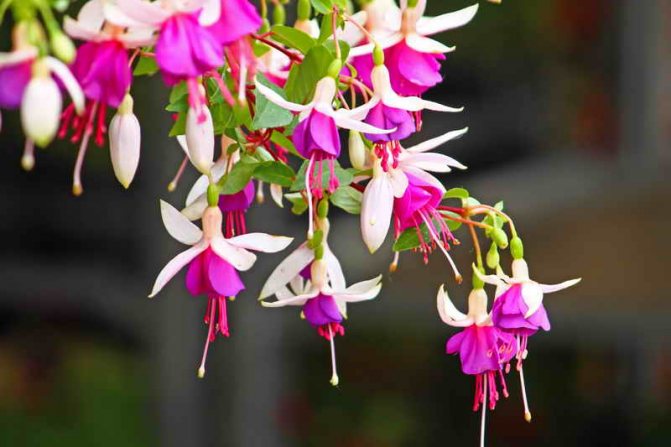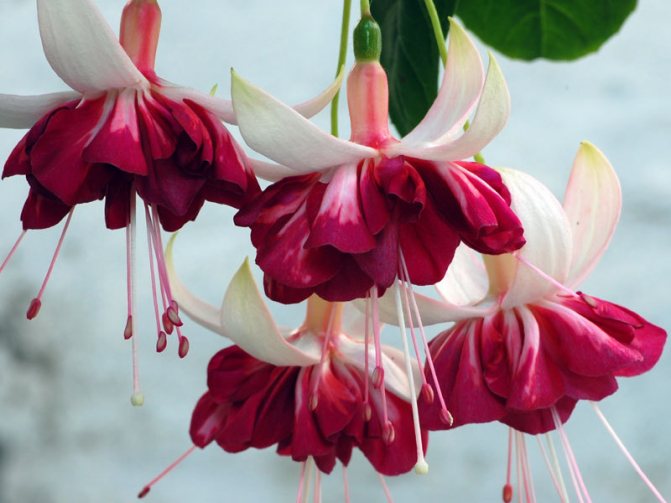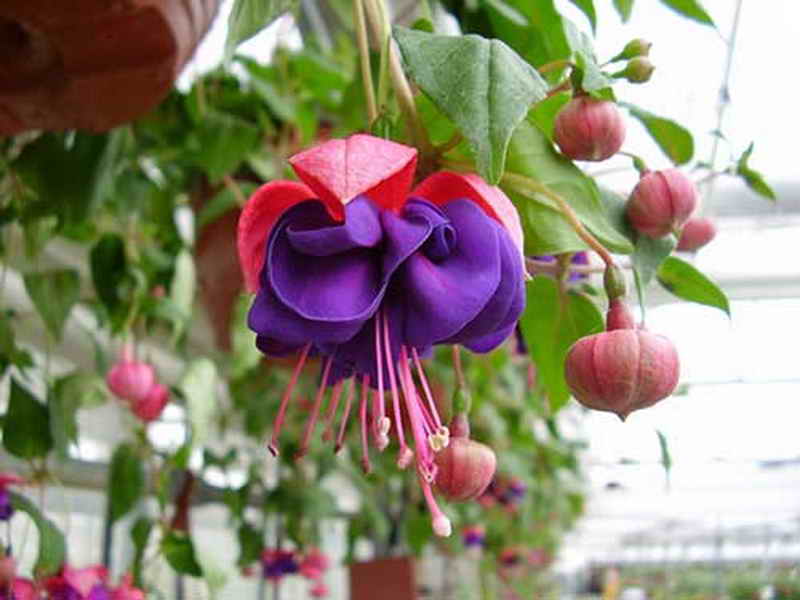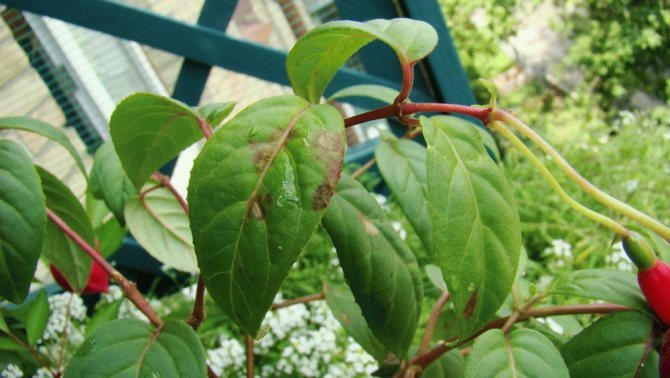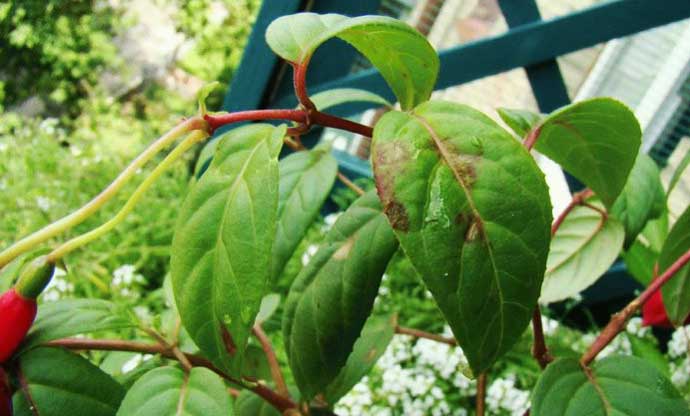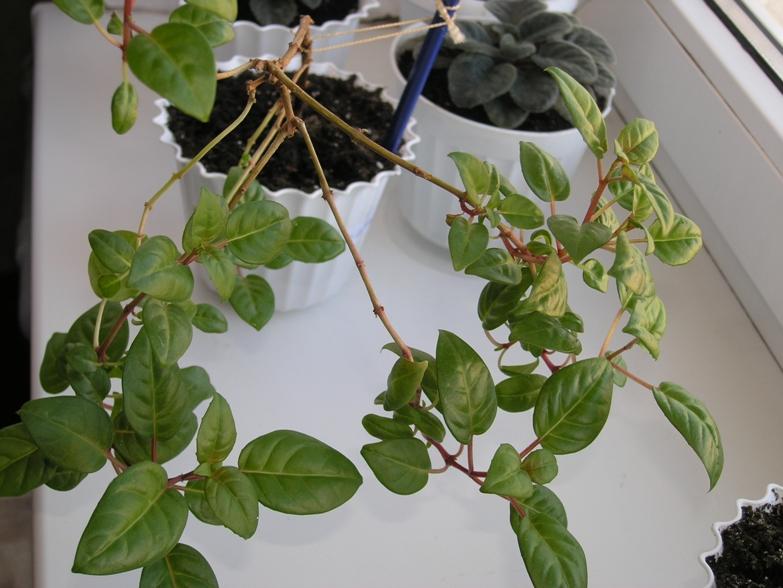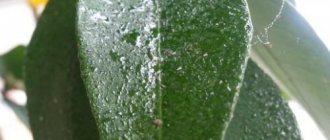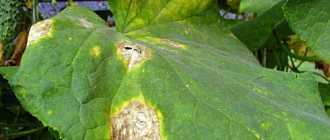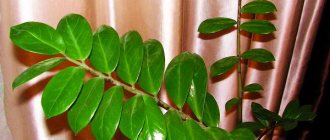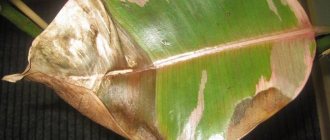Fuchsia diseases, leaves curl, what to do? Houseplant care, fuchsia restoration, elimination of causes and consequences. Read today's article to speed up the recovery of fuchsia leaves.
Fuchsia leaves curl, what should I do?
Let's find out the reason why fuchsia leaves curl in order to start effective treatment. Florists identified several common options: short daylight hours, lack of trace elements, pests.
We talked about diseases of the lower leaves of fuchsia and other causes of wilting in the last article: why fuchsia withers. Curling often indicates a lack of lighting.
How to light fuchsia?
If the leaves of the fuchsia are twirled, most likely the daylight hours are short. Hence, it is necessary to increase its duration. Place the fuchsia in the most luminous place. In winter, the illumination is organized with lamps. We exclude placement in direct sunlight only in the summer.
You can prevent curling of fuchsia leaves by systematic and sufficient lighting, taking into account the normal indicators for other categories of care.
When to feed fuchsia?
The leaves of those fuchsias that lack macro- and microelements for development can curl, become covered with spots, and turn yellow. Standard complex for fuchsia fertilization: a combination of nitrogen + potassium + phosphorus. Closer to the beginning of flowering, the amount of nitrogen is reduced, increasing the remaining macronutrients.
How to feed fuchsia if leaves curl: molybdenum, potassium, zinc.
How to determine which element is missing:
- If spun up - zinc.
- If inside - molybdenum.
- Change in shape or turgor - minerals in general.
How to feed fuchsia? Fertilizers are added to the soil mixture, previously diluted with water. The earth is spilled before the procedure. In spring and summer, fertilizers can be sprayed over the leaves by foliar dressing, but they are introduced under a suitable microclimate.
Air humidity and fuchsia health. Another intermediate factor that partially influences development is air humidity. In winter, it can be either increased or decreased. In summer, the air is often dry. Regulate by spraying and ventilating the room, normalize temperature readings, spill the soil in time, choose a good location.
Fuchsia pests
The leaves are curled by the whitefly, spider mite. Both parasites actively reproduce during the summer.
- Treatment with soapy water saves from whitefly.
- From spider mites - increased air humidity, insecticide treatment.
Often the plant is affected by caterpillars, especially in the open field. They undermine the roots and stems, causing the leaves to wither and curl. Treating with insecticides before the parasite appears and mechanically removing the caterpillars will help restore fuchsia.
Other pests - aphids and nematodes - settle on the leaves, acting directly on the plate and shoots. Having lost the juice, the leaves curl. Parasites live either on the back of the leaf, or "bite" into the leaf, so they are invisible to the naked eye. A thorough examination of fuchsia helps, as well as prophylaxis with insecticides to kill the clutch of parasites at the beginning of reproduction.
Insecticides for fuchsia:
- Actellik.
- Aktara.
- "Decis".
- Other pyrethroids.
Fuchsia is sick, although the care is good
Inexperienced growers complain that the plant sheds its leaves and buds, dries up, the leaves are prone to curling. The reasons for the poor condition are not clear, because they water it abundantly. Then it is necessary to identify why fuchsia leaves curl inward, what to do to restore it.
Fuchsia is a moisture-loving plant, but it does not like high humidity.
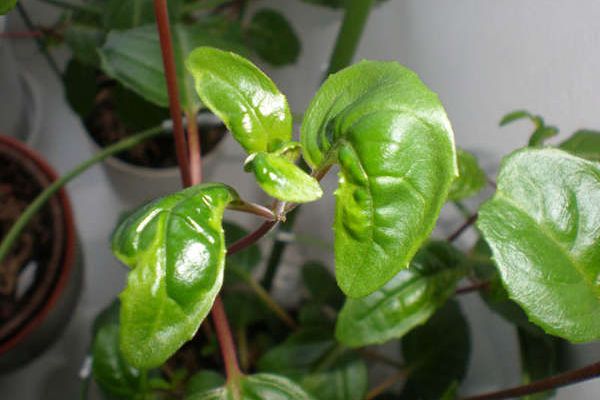
The plant has leaves curled
Useful tips for flower growers
A few helpful tips to help you avoid mistakes when growing fuchsia:
- In the summer, the root system overheats. To avoid this, the flower is planted in ceramic pots with thick walls.
- In order not to expose the plant to stress, it should not be rearranged to another place without special need.
- A lack of light leads to a strong elongation of the shoots to the detriment of flowering. If such a tendency appears, the fluorescent lamp should be periodically turned on.
- An excess of fertilizers, especially nitrogen, leads to an increase in green mass. Therefore, feeding more often than once every two weeks is not recommended.
It is important! In order for the plant to recover faster after the influence of unfavorable factors, it is sprayed with a growth stimulant.
An important nuance when growing fuchsia is creating the right conditions in the winter. It is better to place the pot in the basement or pantry, because the flower does not need light at this time. An insulated balcony is also suitable, but direct sun exposure is undesirable. The main reason why fuchsia dries during the rest period is an excess of light and water. Because of this, spots with a yellow border are formed.
Thus, there are several reasons why fuchsia leaves wither and fall. This is a violation of the rules of care or illness. If you take action in time, the plant will quickly recover.
People who prefer bright and unusually blooming plants always try to have fuchsia. The fuchsia flower shape is very attractive. A variety of colors will not leave any amateur grower indifferent. But in order for the flower to please you with its appearance, you need appropriate care. Therefore, when you decide to keep this ornamental plant at home, get ready to study the peculiarities of its cultivation and maintenance, and find out what to do if the flower leaves wither and fall.
Sapling selection
If you want to purchase this flower, then when buying, you should be guided by certain rules:
- make a purchase only in a verified specialized store;
- pay attention to the attractive appearance of the flower;
- check the availability of a certificate indicating the variety;
- there must be clean foliage without spots;
- see that there is no damaged top of the plant.
Hello Karina!
The reasons for the drying out of the plant can be very different: inappropriate conditions or the attack of pests.
Causes of leaf fall
The flower reacts to any discomfort by dropping its leaves. But there are times when the loss of leaves is considered the norm, for example, in winter. The reasons for falling leaves are:
- new place;
- too much moisture;
- overdrying;
- flowering period;
- drops in humidity.
Phlox diseases and their treatment: why leaves curl
If the plant is moved to a new location, it takes time for it to adapt to the lighting. It becomes clear why fuchsia withers in a pot. The flower reacts painfully to changing conditions, but quickly returns to normal.
Important! Excessive watering provokes root rot. The damaged roots are removed.
Moisture deficiency also leads to loss of leaves. Drying out of the soil occurs due to the air temperature above 20 degrees. The plant does not like overheating of the soil. If the soil is dry, then it should be moistened gradually. To alleviate the condition of fuchsia, you can spray the leaves from a spray bottle.
The tips of the leaves dry out due to changes in humidity when the fuchsia is not acclimatized to a new place.
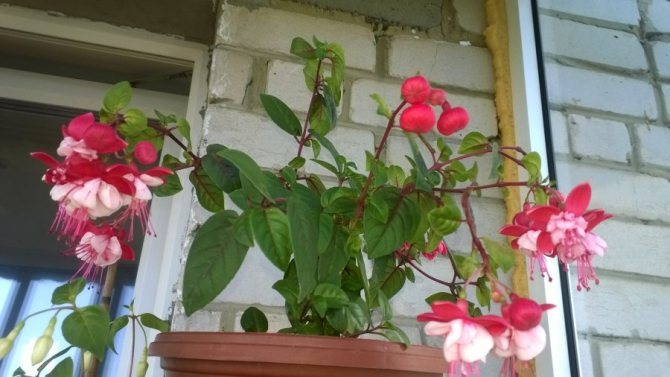

Leaves curl due to bright lighting
Why does fuchsia not bloom
What to do in such cases? Where to look for the reason? The reason most often lies in improper care. This may be excess moisture, in which the roots rot. In this case, you need to adjust the watering. Fuchsia will not give flowers even if it lacks light. Since she is painful to permutations, you need to initially take care of sufficient lighting. If the flower is located near the north window, you can only help here with additional light sources.
If the plant lacks trace elements, it will also respond with a lack of flowering. But it is necessary to remember that an excess of nitrogen also leads to this. Therefore, feeding must be strictly balanced. In winter, the temperature for fuchsia was not provided - it was too hot. In this case, you can help by carefully moving it to a room with a low temperature for several days.
Too large a pot is a common cause of lack of flowers. When the roots have an excess of space, they grow first, then the leaves. All the plant's strength is spent on this. There is only one way out - to transplant fuchsia into a tighter container.
Fuchsia breeding
There are several main types of breeding fuchsia bushes. Choose the most convenient and suitable option: - cuttings; - seeds; - leaves.
For propagation using cuttings, the period from February to March, occasionally September or late summer (for slowly growing varieties) is suitable. Take cuttings up to 7 centimeters long so that they can take root in loose fertile soil, a mixture of sand or water. The roots begin to develop after 25 days, after which you can transplant the seedling into pots 9 centimeters in diameter. It is desirable that there was always sand, humus, leaves and sod in the soil in equal proportions... You can get a lush blooming fuchsia by planting several cuttings in one pot - young shoots will bloom in the same season.
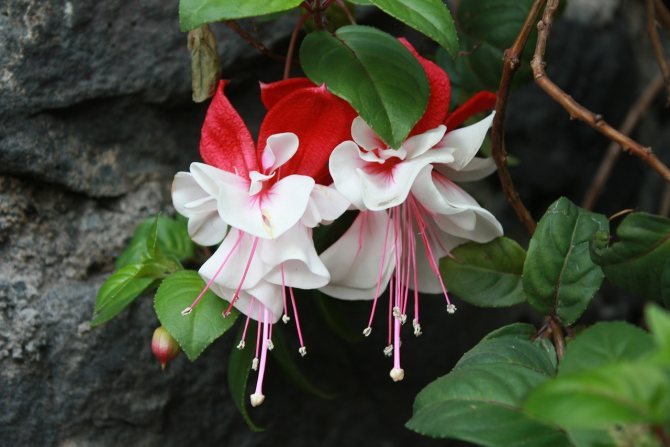

How to identify the problem by its external signs
Why do hydrangea leaves curl and wrap in a boat
In the case of a bay or under the influence of sunlight, fuchsia has similar external manifestations. The leaves become wilted, drooping. The bay is excluded if the flower comes to life in a cool place.
If fuchsia begins to fade, sheds leaves, buds, then, apparently, it was rearranged to a new place and it takes time to adapt.
If a powdery bloom is observed on the reverse side of the leaves, and the buds began to fall off, then the plant was attacked by pests. Lack of flowering, slow growth are associated with a low content of nutrients in the soil.
Brown spots on the leaves - due to sunburn, wrinkling of the leaves - due to watering with cold water.
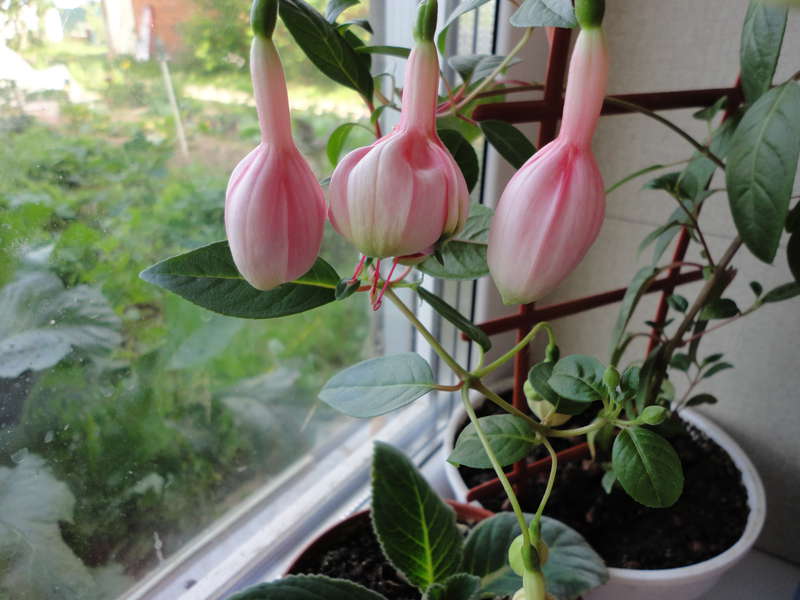

It is important to fertilize the soil during the flowering period.
Why do tulips have leaves curled?
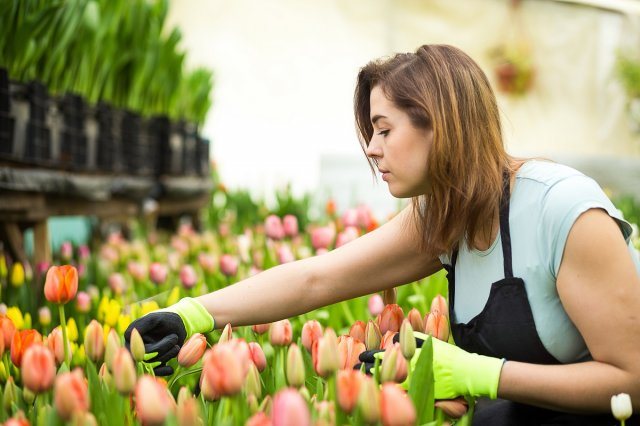

Tulip leaves most often curl after being damaged by botrytosis, or gray rot, a fungal disease that activates on plants during budding. The bulb can also become infected during winter storage. To avoid starting the disease, spray the flower bed with 1% Bordeaux liquid. If there is no improvement, it is better to dig up diseased plants and destroy, and replace the soil in which they grew with a new one.
Sudden changes in temperature and watering problems can also affect the appearance of the leaves. Do not forget to inspect the plants for the presence of pests in order to treat them with insecticides in time.
Possible problems
Problems that a florist may face:
- Fuchsia does not bloom. The reasons for this:
- In winter, the flower was warm.
- Excessive watering.
- In warm weather, watering was rare or there was not enough top dressing.
- There is little light during the growing season.
- The leaves of the flower wither, dry and fall off. The reasons for this:
- The air in the room is dry, the soil lacks moisture.
- Fuchsia buds do not open. The reasons for this:
- Excessive moisture.
Very often, any problems with a flower do not signal diseases and pests at all, but indicate improper care. In this case, you do not need to resort to different means, it is enough to pay due attention to fuchsia.
We care properly
Once again, we recall the fact that diseases and pests appear in fuchsia due to improper care.
Fuchsia has a large number of species. Its flowers have a different color palette. Therefore, all the colors of the rainbow can be collected on the windowsill.
- Watering. In the warm season, the flower needs frequent and abundant watering. As soon as you see the drying topsoil, feel free to grab the watering can. In cold weather, watering is significantly reduced. In the last 2 months of autumn, watering can be stopped altogether. When the room temperature is low enough, watering is carried out a couple of times a month.
The water is used settled, it is impossible to water from the tap.
- Shine. All types of fuchsias love bright lighting. It should be absent-minded. The scorching sun has an adverse effect on the flower. During flowering, fuchsia is not twisted or rearranged, otherwise the whole color will crumble.
- Temperature. During the growing season, the optimal temperature regime is 18-25 degrees. In the summer, the flower can be planted in open ground. Temperatures over 30 degrees are fraught with the following consequences:
- Leaves fall.
- Flowering stops.
- The flower dries up.
On hot days, fuchsia is removed from sunny windowsills, it is advisable to take it to a balcony or loggia. The direct rays of the sun will destroy the flower.
The heat is also harmful to the root system, so it is recommended to use ceramic pots for planting, they are not subject to strong heating.
- We fertilize and feed. Fuchsia during the growth period needs regular spraying of the leaves. It is better to do this in the morning and evening. To humidify the air, a container with pebbles (pebbles) filled with water is placed near the flower pot. In cold weather, moisture will be harmful, spraying is stopped.
As top dressing, you can use any commercial products that are intended for indoor plants.
In winter, fertilizer is not needed, they begin to add it at the end of March. Frequency - once every 7 days, before the onset of cold weather.
- Transfer. This point is very important, since when using poor-quality soil, various diseases can develop, pests (for example, aphids) will appear.
The flower should be transplanted annually in the spring. The soil is obtained from a flower shop. Be sure to put drainage on the bottom of the pot so that there is no excess moisture. The pot is chosen in large sizes.
- Reproduction. It is also a very important factor, during this period the flower needs special care, since it is during reproduction that it is considered the most vulnerable and weak.
Fuchsia can be propagated in 3 ways:
Propagated by cuttings. I start the process from the end of winter, the beginning of March. Those varieties that grow slowly can be propagated in late August, early September. Cuttings are selected 5-7 centimeters long. Rooting works well in a loose environment. It can be either sand or water. In less than a month (20-25 days), you will see the first roots. At this point, the cuttings can be planted in pots, 7-9 centimeters deep. You can prepare the soil yourself, it should contain:
- Humus.
- Sand.
- Leafy or turfy ground.
All components are mixed in equal amounts.
For the splendor of the flower, several cuttings are planted in one pot. They can be expected to bloom in the same year.
Propagated by seeds. To plant seeds, artificial pollination is required. This is a very interesting process. You can mix several types of fuchsias.As a result, new varieties will appear, the color palette will expand its horizons.
Propagated by leaves. This type of reproduction should be carried out according to a clear scheme:
- I choose a strong stem. Strong and developed leaves should be present on it.
- The resulting "material" is placed in loose soil to a depth of no more than 1 centimeter.
- The planted leaves are covered (you can use plastic or glass lids).
- Spraying is carried out daily.
- You cannot take water from the tap, it must be boiled and warm. Be careful not to burn the plant!
- The appearance of the first small rosettes indicates the need for transplanting in pots.
By propagating fuchsia, you can get various and magnificent varieties and types. It is better to do it yourself, then you are sure that the plant will grow strong and healthy. Brought seeds, sprouts, leaves from the "street" may have various problems that will have to be dealt with. At worst, they will infect other indoor plants as well.
Diseases and pests
Fuchsia is resistant to disease, but high humidity leads to the appearance of small dewdrops on the leaves. The plant can be treated with a solution with Fundazol in a ratio of 11: 1.
Why do the leaves of indoor flowers turn yellow - what to do
Of the pests, aphids, spider mites, whiteflies are dangerous. Aphids can be seen from above on young stems, buds. Aphids suck the sap from the plant, the leaves curl up, become dry. The drug Decis fights well with aphids.
Important! Aphids are firmly attached to the stems due to the secreted sugary substances. Infected stems must be separated from healthy ones.
Whitefly control methods on fuchsia
In the summer heat, the windows of almost all apartments remain open, so the whitefly enters the living room. The whitefly is a very small butterfly that is difficult to see with the naked eye. She only needs a couple of hours - and the whitefly on fuchsia will lay its very small testicles. It is almost impossible to notice them, but the reaction of the flower is lightning fast. White midges appeared on fuchsia, what should I do?
The leaves of the plant begin to become covered with small sticky droplets, the number of which increases daily, even if they are constantly removed. As soon as the first larvae begin to appear from the eggs, they immediately suck the juice from the leaves, which leads to their rapid wilt and death.
At the first manifestation of the whitefly, the plant must be thoroughly rinsed with running water and laundry soap. Especially carefully you need to wash the stem and the inside of the fuchsia leaves.
Important!
When washing a plant using laundry soap, it is better to cover its roots with plastic wrap, since they categorically do not tolerate soapy water.
After water procedures, the leaves and trunk of the plant are treated with chemicals, Angara is best suited.
Fuchsia, worse than all indoor flowers, resists the attack of white midges. It will not be saved by ordinary folk remedies that are used to treat other flowers. In the case of fuchsia, only chemical agents will help, and even in tandem with a soapy bath.
After completely getting rid of the pest, the plant must be transplanted into a new ceramic pot with fresh soil. And only then can one begin the necessary work to restore the vitality of the flower.
Insufficient watering
Poor watering negatively affects the well-being of fuchsia, the leaves become withered. Especially at high air temperatures. Looking at the top layer of soil, which dries up to dust, it is clear why fuchsia withers. The soil should be moistened with small portions of water.
Lack of nutrients
Fuchsia needs feeding all year round, except for winter. A deficiency in nutritional ingredients affects the health of the plant, the leaves turn yellow, the plant stops blooming. Fuchsia leaves are falling, what should I do? - to feed. Fertilizers are added once a week, starting in March. When the fuchsia fades, take a short break, then feed again.
It is important to transplant the cuttings into soil rich in beneficial microelements.
Why begonia leaves curl
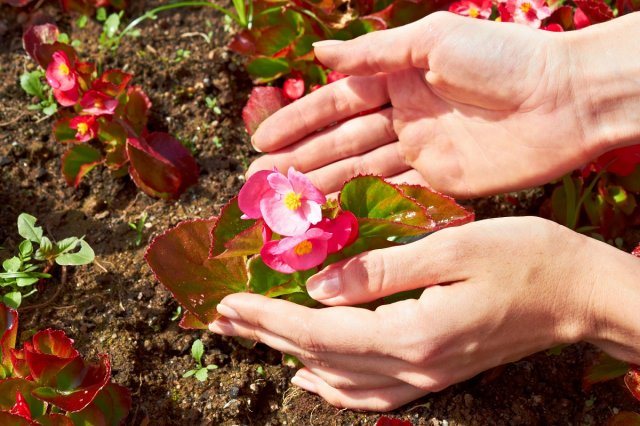

Tuberous begonia is very sensitive to high temperatures and improper watering. It is better to plant this plant in partial shade so that it is not scorched by the sun's rays. When it comes to watering, just like with other flowers, there must be a balance. Perhaps you overflowed the soil or did not moisten the soil in time.
In a tuberous begonia, the leaves also curl because it has not received enough nutrition. Feed the plant twice a year with a compound fertilizer according to the instructions, and its leaves will grow even.
Types and varieties of fuchsia photo
When growing fuchsias at home, about 2000 hybrid varieties are usually used, including erect shrubs, dwarf shrubs, ampelous, dwarf and standard plants. It is in hybrids that the corolla and calyx have the greatest number of color combinations, as well as a variety of types of flowers - double, semi-double or simple, large or small.
Large-flowered hybrid varieties of indoor fuchsias are often united by a common name for them - beautiful fuchsia, or beautiful, is the result of crossing shiny and sparkling fuchsia.
Among the small-flowered fuchsias, the following groups are most often found:
- F. three-leafed - a hybrid, which is a short, well-branched bush. Ovate oblong leaves are very decorative in color: on top they have a reddish tint, and below they are brownish-red. flowers are long and narrow, bell-shaped, painted most often in bright red and orange tones. This species blooms from May to October. Looks good in hanging pots.
- F. Magellan, suitable for large rooms, as well as for open ground, since it can reach 3 meters in height. The leaves are medium-sized, the flowers are axillary. Tolerates frost if cut and covered securely.
- F. recumbent - the ancestor of ampelous hybrids and varieties. Small flowers, unlike many relatives, are directed upwards. It can also be grown in standard form, but is more often used for grafting on stems.
- F. brilliant (sparkling) - an evergreen bush, branches are lignified, in the lower part they often acquire a reddish-brown tint. Blooms profusely from June to October, fruits are edible.
- F. graceful, with shoots looking down. The flowers seem to float on threadlike, very thin pedicels. Their corolla is usually reddish-purple, the calyx is colored red or pink, and the pistil and stamens are bright red.
- F. Bolivia is distinguished by abundant early flowering - from March or April. Inflorescences reach a length of 30 centimeters. She needs warm rooms.
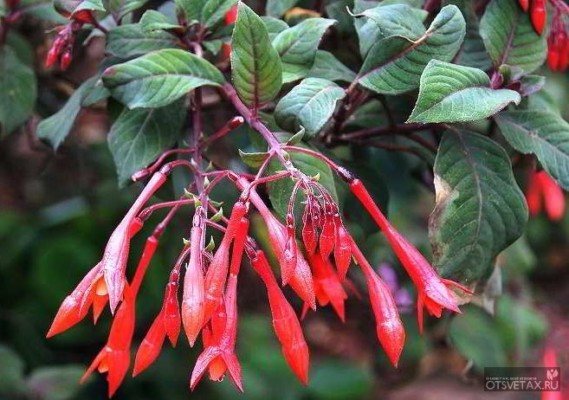

f. triphylla (f. tryohlistnaya)
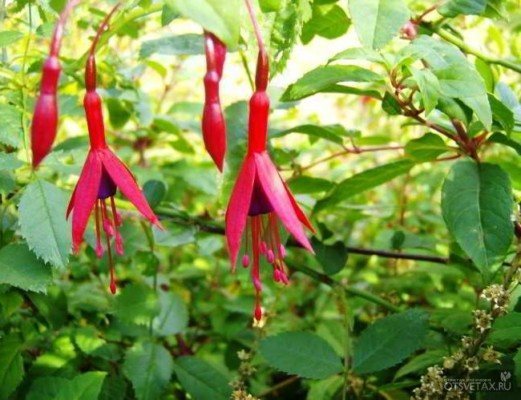

f. magellanica
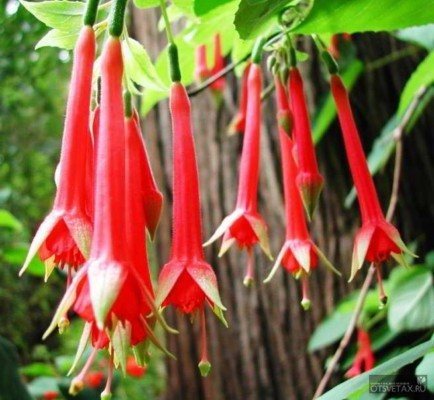

f. fulgens (f. blestyashhaya)
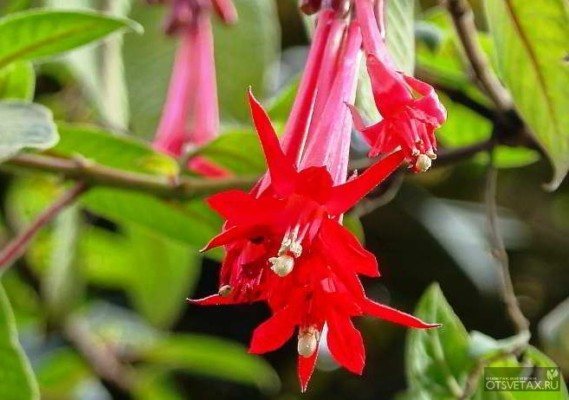

f. boliviana
It is simply impossible to list hybrid fuchsia varieties intended for indoor cultivation - there are more than two thousand of them, each more beautiful and elegant than the other.
The most common varieties of hybrid fuchsia are:
- "Alfred de Groot", erect, mauve petals-skirt and delicate pink sepals;
- "Annabel" - bush and ampelous, her flowers are large, double, with a white "skirt" and sepals, painted from white to pale pink;
- "Ballerina" is an erect plant with scarlet sepals and a lush white or pale pink "skirt";
- "Cecile" is an erect bush with dense double flowers, delicate red sepals, in a bluish-lilac "skirt" with a wavy edge;
- "Marinka" - ampelous fuchsia, its bright red flowers are simple, but always in huge quantities;
- “Prince of Peace is an ampelous variety with simple flowers, very decoratively colored - a bright red or lilac corolla-skirt with white sepals;
- "Santa Clara" - also an ampelous variety, large, double flowers, cherry-colored "skirt" with white transitions and white sepals;
- "Voodoo" - erect, large double flowers, "skirt" has a dark blue-violet color, and sepals - bright red.
Plant lighting requirements
Fuchsia feels good under diffused sunlight at the beginning and at the end of the day, and suffers from the heat of the day. For lush bloom at home, create a balance between intense daylight and shade from the scorching rays of the sun. Varieties with bright flowers require more light, and they happily stand in the open sun. Fuchsias with inflorescences of delicate shades like to be in lacy shade.
To place fuchsia in an apartment, windows are chosen from any side, except for the south. Otherwise, the leaves of the fuchsia will fall off.
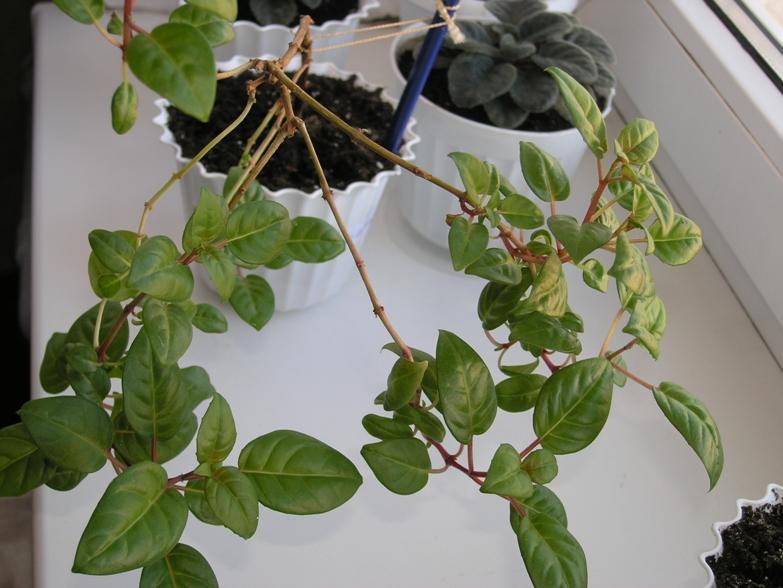

Due to high humidity, the flower has a painful appearance.
Air temperature and lighting on the way to healthy fuchsia
If the leaves of fuchsia dry due to an increase in temperature
, set it between the permissible levels of + 22-25 ° С and enjoy flowering against the background of green, healthy leaves. Remember spraying as an additional care procedure. Exclude direct sunlight from the midday sun by shading fuchsia. You can hang blinds or special diffusing grilles on the windows - interesting and beautiful for the interior, useful for fuchsia.
If there is not enough sun in the spring and autumn periods
, say, when the weather has not had time to return to normal, additional lighting will be required. Expose under lamps, in the brightest place, increase the sunny day, and, as the weather recovers, return to the previous conditions.
Indoor fuchsia - description and origin
This very beautiful, brightly flowering houseplant belongs to the fireweed family. Its wild ancestors and relatives grow in the mountain forests of South and Central America, New Zealand, Tahiti and the Falkland Islands. She began to conquer Europe in the 17th century, when a spectacular garden culture was bred from a wild weed by the French botanist Charles Plumier.
Fuchsia in home growth is a low evergreen shrub that grows up to 80 centimeters. It cannot be confused with any other indoor plant, it has such unusual flowers. For their shape, they are often compared to Chinese lanterns. Delicate sepals and petals are painted in bright colors, and the flower itself surprises with its some kind of unreal beauty, as if it were not a creation of nature, but a fantastic idea of a needlewoman.
Modern indoor fuchsia has ampelous, bush or standard varieties. Its leaves are most often opposite, whorled less often, and even more rarely alternate. They have a lanceolate or ovoid shape, the edges are serrate, crenate, solid.
Care rules during the flowering period
After wintering, the plant needs help for healthy flowering. Dried leaves are trimmed, dead flowers are removed. The branches that have grown inside are taken out and removed.
During the flowering period, growth retardation, lack of flowers are often observed. This is due to poor soil, insufficient amounts of nutrients. The plant requires potassium, phosphorus, so it needs to be fed.
Fuchsia is actively developing the root system. The pot should be spacious.
Fuchsia fading? Do the leaves dry and fall? Save fuchsia from the bay!
One of the most common causes of fuchsia death in summer is the bay.
The importance of proper watering for fuchsia cannot be overstated. It is the basis for a healthy and strong plant.
Signs of the Gulf
- Shoots droop
- Leaves wither, then become covered with brown spots, dry and fall off
- Flowers and buds are crumbling
In hot weather, fuchsia leaves become lethargic and drooping.
What's going on? Fuchsia has a water regulation system that allows the plant to close its stomata and thus prevent water loss. But the stomata must be open to allow carbon dioxide access for photosynthesis. Therefore, the plant has to balance between water loss and carbon dioxide assimilation.
The stomata open early in the morning. At about noon they begin to close, and close completely just before sunset. On very hot days at temperatures of 25 ° C and above, the stomata are open for a very short time in the early morning and closed for the remainder of the day. The same happens if the plant does not have enough water: the stomata are open for a very short time to retain water. Under these conditions, respiration and photosynthesis stop, and the leaves no longer cool during evaporation - as a result, the plant wilts.
Watering fuchsia abundantly in this state is a guaranteed death of the plant.
Watering with closed stomata of the plant can lead to death, because closed stomata cannot provide the movement of water to the leaves.
The best thing to do for a wilted plant in the sultry heat is to spray the leaves.
Spraying allows the leaves to cool and helps keep the stomata open longer. You should also do this on hot days to prevent the leaves from wilting. Proper spraying in hot weather also helps keep the stomata open longer and thus support plant growth. Spray fuchsia in the shade!
Proper watering
So, watering is important in the early morning. Watering in the afternoon can do more harm than good. At this time, the stomata are closed, and the roots will be in the water all night and may rot.
How to save fuchsia after the bay?
If you spot these signs of bay on your fuchsia, rescue it urgently!
- Leave the plant in the shade.
- Remove excess water from the soil as quickly as possible. This can be done by placing the pot on a wad of napkins, newspaper, or dry sand.
- Also, an emergency transplant into a new, light and airy soil can solve this problem.
- Do not water the plant, just spray it with a spray bottle. Until the roots recover from the bay, they cannot fully absorb water from the soil.
- It makes sense to cut off the stalk and put it on rooting. If the plant cannot be saved, the cutting will give life to a new fuchsia.
So, you can save fuchsia from the bay if you eliminate the cause as quickly as possible. And having faced this situation once, you will no longer allow unnecessary watering of fuchsia, especially in the heat.
Plant watering requirements
Excessive watering disrupts gas exchange in the soil, provoking its acidification. A moldy crust forms on the surface. The root system is deficient in oxygen, the roots gradually rot, and the small roots quickly die off.
Proper adherence to watering rules will help to avoid fuchsia diseases. In the spring-autumn season, fuchsia needs good watering if the topsoil dries. In winter, watered in the morning, in moderation.
In the autumn period (October-November), watering is reduced until it is completely canceled. In the cold season, 1-2 waterings per month are enough for fuchsia.
When it's summer outside, the flower is watered in the evening. Due to morning watering, the roots soar in the heat in moist soil, deteriorate.
Important! The soil should be kept slightly moist and the leaves should be sprayed to cool.
Florists equip the pot with a drainage system to prevent soil acidification.
For irrigation, use settled, soft water. Oxalic acid is used to soften.
Why do hydrangea leaves curl
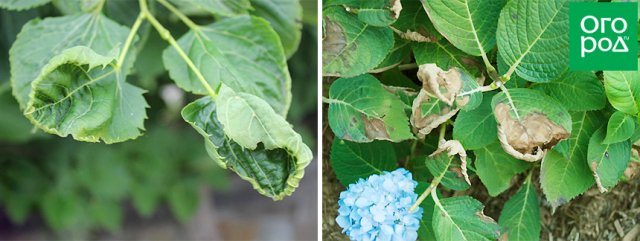

Has hydrangea lost its decorative appearance due to deformed leaves? First of all, exclude pest infestation and inspect the bushes for the presence of aphids and ticks. Like other plants, hydrangea may have suffered from viral infections, so do not delay treatment asit cannot be saved at a late stage.
If, in addition to twisting the leaves, the shoots dry and the buds are deformed, the hydrangea gets sick with chlorosis. This disease manifests itself when there is a lack of iron in the soil. Preparations, for example, Ferovit, will help to save the plant. You can also use the folk method: dissolve 2 g of ferrous sulfate and 4 g of citric acid in 1 liter of water. Spray the bushes, and in especially severe cases, root feeding.
Hydrangea is sensitive to herbicides, so if they were sprayed on the site, the plant could get poisoned, as a result of which the leaves curled. In this case, he will need time to restore immunity. No treatment is provided.
Fuchsia flower: how to care at home
Fuchsia care consists in creating suitable conditions for its growth and development:
- maintaining optimal temperature conditions;
- regular watering;
- feeding.
Young cuttings are placed in small pots, which increase in volume as they grow. Immediately after planting, they are not fed, because the fresh soil is saturated with the necessary elements.
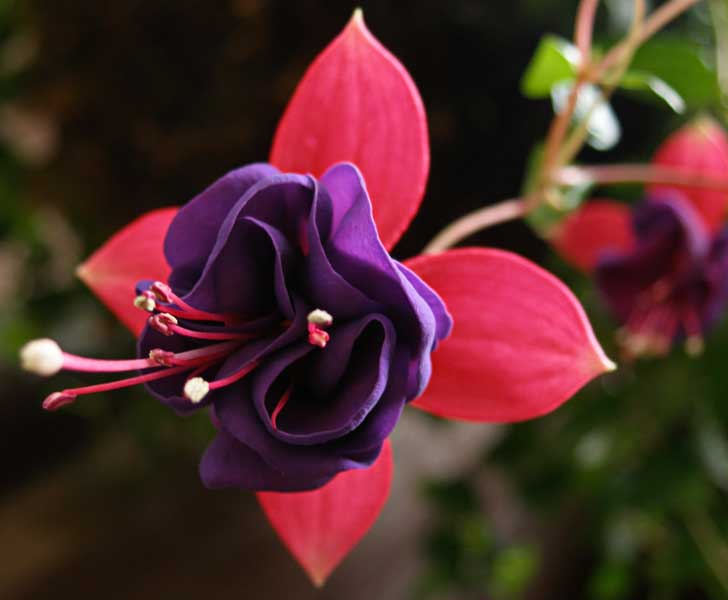

Fuchsia
Particular attention is paid to the formation of the bush. Some fuchsia varieties grow up to three meters in height. To prevent active stretching, after wintering, dried leaves and flowers are cut off, the stems are shortened by a third. They also remove shoots that grow incorrectly - at an angle or inside the plant. In the spring, the tips of the branches are pinched.
Then fuchsia is transplanted if the roots grow through the drainage holes. Too spacious pots are not used. In such containers, the green mass increases to the detriment of flowering. Sand and humus are added to the soil mixture to make it looser.
It is important! Drainage must be placed in the pots. For active flowering, add horn or bone meal (1 tablespoon per 1 liter of soil).
Fuchsia is considered a finicky flower, but it is not so difficult to care for it. Maintain a comfortable temperature, adequate lighting, water and fertilize. The first thing to do when the fuchsia withers or throws off the leaves is to review the care measures.
Requirements for temperature and watering
The optimum temperature during the period of active vegetation and flowering is + 18 ... + 25 ° С. In the heat (above + 30 ° C), leaf fall is observed. Plants can dry out. Direct sunlight also has an adverse effect. It is better to cover the windows with curtains.
In autumn, the temperature is lowered to + 10 ... + 12 ° C, because the plant begins a dormant phase. It should gain strength to bloom in the new season. If it gets hotter, the leaves will be crushed and the flower will get sick.
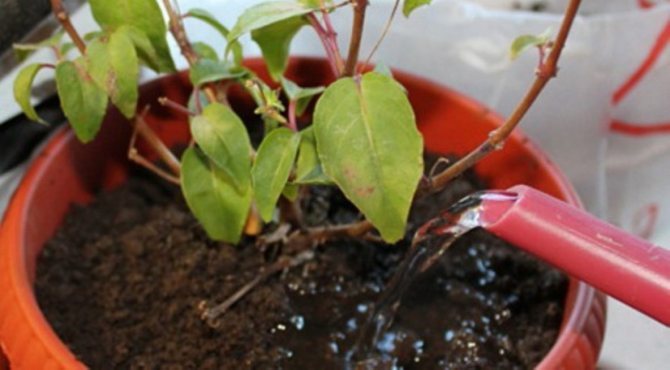

Watering home fuchsia
Fuchsia constantly needs sufficient watering, except in winter. The earth is moistened as soon as the topsoil dries up - approximately every 3-4 days. It is necessary to maintain a balance - the plant does not tolerate drought, but does not like excess water either. If liquid accumulates in the bottom pan of the pot, drain it immediately. In winter, the frequency of watering is reduced to 2-3 times a month. The optimum humidity in the room is 50-60%.
When flooding, the following signs appear:
- sluggish stems, leaves and inflorescences;
- brown spots on the shoots.
How to properly reanimate fuchsia:
- move to shadow;
- remove excess water by placing a paper towel or container with sand under the pot;
- transplant into new soil - light, saturated with oxygen.
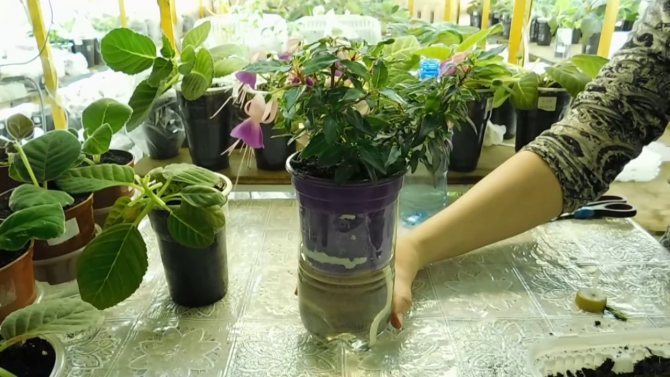

Fuchsia transplant
In advanced cases, when the flower can no longer be saved, only cuttings can help.
The plant accepts well spraying of green mass during the growing season. The procedure is performed early in the morning or late in the evening, when there is no direct sun.
It is important! Watered only with clean, settled water. Hard tap liquid leads to the formation of yellow leaves.
Spider mite on fuchsia. What to do?
The optimal conditions for the appearance of a red spider mite is warm and dry air in the apartment.The main symptom of the appearance of the pest is a gray coating on the inside of the fuchsia leaves, many small black dots and cobwebs.
It is unlikely that it will be possible to remove this insect by washing the plant. That is why it is best to use chemicals such as Fufanon.
Important!
When using any chemicals, you must act strictly following the instructions.
A complete disinfection of all auxiliary tools that are used to care for indoor flowers is required, as well as immediate isolation of the diseased plant. This is the only way to avoid an epidemic and the death of other flowers.
A dancing flower or a ballerina is called fuchsia. Once you see it, this plant is hard to forget. The original bright flowers really float in the air, like ballerinas in a bewitching dance.
In Russia, some people call fuchsia "Grandmother's plant"
,
"Japanese lantern"
, and to someone her flowers resemble the fluttering of exotic butterflies.
For Europeans, fuchsia was discovered in 1665 in the foothills of Santo Domingo during his third expedition by a French scientist who was called the king of botanists - Charles Plumier
, artist, writer, author of many scientific works, which were highly appreciated and used by Karl Linnaeus.
Charles Plumier named the plant after a German botanist and physician Leonard von Fuchs
, head of the medical department at the University of Touring, who was born in Bavaria in 1501.
The full name of fuchsia in Latin is Fuchsia Triphylla Flore Coccinea
.
In the XYII century, fuchsia came to Great Britain and then spread throughout Europe.
Fuchsia fascinated not only botanists, but also alchemists. Thus, the Dutch society of alchemists, called the "Brotherhood of the Rose and the Cross", attributed magical properties to it.
In a cup of fuchsia, which consisted of four cross-shaped lobes, alchemists saw, and opposite leaves, arranged in pairs crosswise, reminded them of the magical signs of a cross and a rose.
The Rosicrucians dedicated fuchsia to the goddess of love, seeing in a flower such qualities so valued by men in women as grace, tenderness, softness, warmth ...
Fuchsia
- an evergreen or deciduous shrub from the family of onagrikovy or primrose.
In nature, there are about 100 species of fuchsia, which, in addition to South America, are common in New Zealand and Polynesia. In their homeland, fuchsias are not only shrubby, but also tree-like and carpet.
In indoor conditions, fuchsias look like bushes, ampelous plants and, less often, standard trees 40-100 cm tall.
Young stems and petioles of fuchsia have a reddish tint.
Leaves are green or slightly reddish, small, on long oval or ovoid petioles, pointed, with denticles along the edges.
Single flowers on thin legs hang down and are collected in inflorescences - brushes.
Each individual fuchsia flower consists of a calyx with four pointed, bent sepals and a bell-shaped corolla, which can be simple, semi-double and double. Stamens and a pistil hang from under the corolla.
Flowers can be painted in white, pink, red, purple, there are fuchsias with a double color. The sizes of different fuchsia varieties are different.
Blooming of all fuchsias is long lasting - from spring to late autumn.
Many amateur flower growers, who are not indifferent to fuchsias, collect whole collections from them, choosing plants in such a way that they can enjoy their flowering almost all year round.
During flowering, fuchsia not only cannot be rearranged to another place, but even just move the pot. Otherwise, the plant will drop both flowers and buds that have not yet opened.
Fuchsia fruits are dark red, from which jam and marmalade are prepared. However, fruiting for domestic fuchsias is a heavy burden, often the plant can be depleted after it.Therefore, most growers remove faded flowers.
And only super-experienced specialists allow themselves the luxury of enjoying the taste of fuchsia fruits and leaving them for seed reproduction.
Before the revolution, fuchsias were very popular in Russia, but the new government, together with the geraniums on the window, were called symbols of the bourgeoisie. And only in the 70s and 80s of the last century, love for fuchsias in our country flared up with renewed vigor.
Fuchsia is a rather unpretentious houseplant.
It can even grow on the northern windows, but the most abundant flowering occurs in fuchsias standing on the western and eastern windows.
The southern windows are too sunny for her. Light partial shade, diffused light are the best friends of this plant.
Fuchsias prefer a temperature of + 20-25C. Fuchsias do not tolerate temperatures above + 27-28C, on hot days they need to be hidden in the shade or removed to the back of an apartment or office. In this case, the pots should be wrapped in light-colored paper.
The bright sun is contraindicated for fuchsias. In the heat around the pots, experts advise to lay out ice cubes, specially frozen for this in the freezer.
Fuchsias should not be grown in plastic pots, only ceramic or earthen pots, so that the roots of the plants do not heat up. The pots should not be small to match the size of the plant.
In the summer, if possible, fuchsias are taken out and buried in the ground together with the pots. They look very beautiful in the openwork shade of bushes and trees.
In the summer, fuchsias need abundant watering. However, there should be no stagnation of water.
In winter, watering is moderate, but the earthen coma should not be allowed to dry out.
In summer, fuchsias need splashing and bathing.
From spring, from about the end of March - beginning of April until autumn, fuchsias are fed with mineral and organic fertilizers bought in a store.
Fuchsias are suitable and fertilizing once a week with liquid fertilizers for balcony flowers. In winter, the plant is not fed.
The best temperature for wintering fuchsias is + 10C, but plants also winter at room temperature, only they often shed their leaves.
In a heated room in winter for fuchsias, you need to create increased air humidity. Place containers with water next to it, often sprinkle around the plant.
For the winter, the stem of the plant is shortened by 1/3, removing the remaining buds and flowers to give the fuchsia to gain strength.
Fuchsias are not picky about the soil. Drainage from expanded clay or small pebbles is placed on the bottom of the pot. An earthen mixture is prepared from leaf or turf soil, peat and sand in a ratio of 3: 2: 1. You can add a little bit.
Fuchsias are transplanted in early spring, after a dormant period.
The transplanted plants are placed in a well-lit place, cut off, leaving shoots 10-15 cm long, watered and sprayed well.
Many amateurs plant fuchsias in open ground at the end of May - June, where they bloom profusely until September-October.
Fuchsias endure light autumn night frosts without harm to themselves.
In this case, the plants are dug up in autumn, transplanted into pots or containers, cut off and kept at a temperature of + 5-10C.
At a temperature of + 15-20C, fuchsias bloom in winter, especially when artificially illuminated.
Fuchsias propagate by cuttings in March-April and summer.
Cuttings, about 10 cm long, taken from slightly lignified shoots, are planted in a mixture of sand and peat, or a layer of drainage is poured into a bowl, then a layer of soil, and on top - large river sand well washed, covered with a jar, moistened, sprayed daily warm water, wiping the inside of the jar with a cloth, pinch the top of the handle.
Some people root the cuttings in a jar of water.
Fuchsias are sometimes attacked by aphids. To combat it, the plant is wiped with a cotton swab dipped in alcohol and treated with an insecticide (actellik, 1 ampoule per 1 liter of water). Processing until the plant is completely cured is carried out every 3 days.
The same treatment with actellic is carried out when a whitefly attacks.They also use the drug "Aktar". Use it strictly according to the attached instructions and in the fresh air.
For prevention, the crown of plants is washed with a lukewarm shower with a pot covered with a film.
Spider mites are destroyed by spraying and washing the leaves, especially from the underside, with a shower stream or infusion of onion peels.
Tobacco infusion is also suitable.
Autumn pruning also helps to get rid of pests.
Fuchsia is a very kind and optimistic plant, it inspires hope and lifts the spirit, does not give despair and attracts all good things under the roof of a house or office.
I share the beauty! Good mood, rich harvest and sunshine to everyone!
And a little more information about fuchsia pests and measures to combat them!
Whitefly
The most common pest of fuchsia is the whitefly.
These are small (up to 2mm) white flies. They got their generic name because both pairs of wings are covered with white pollen. Outwardly they look like a microscopic moth. Large colonies of these insects, adults and larvae live on the lower surface of the leaf. They are easy to spot because when shaking the foliage of the plant, the flies fly up en masse.
The larva has 4 instars. In the first, it is mobile, with legs and antennae. Its task is to find a suitable place to attach it on the sheet.
In subsequent instars, the larva is already immobile: it firmly "sticks" to the leaf and sucks out the juice through the stylet immersed in the tissue. During this period, the larva resembles a transparent flat scale.
During mass reproduction, such scale larvae completely cover the leaves. The consequence of this lesion is yellowing of the leaves, shredding of flowers, drying of the shoots. Like other sucking insects, the whitefly secretes sweet honeydew on which sooty fungi develop. Whitefly is also dangerous as a carrier of viruses - pathogens of plant diseases.
At the fourth instar, the larva turns into a pupa. It changes greatly, becomes convex, opaque, covered with waxy secretions on top.
After molting, the pupa turns into an adult insect.
There are several types of whitefly: citrus, greenhouse, tobacco.
Citrus whitefly damages subtropical trees and shrubs in the south of Krasnodar Territory and in greenhouses.
The greenhouse whitefly is a species of tropical origin. It does not overwinter outdoors. But in greenhouses it hurts all year round. It gives 5-7 generations per year.
Tobacco (or cotton) - outwardly does not differ from the greenhouse, but has some features in development. Differs in high resistance to pesticides.
Control measures
Good results are obtained by spilling all plants 3-4 times with the preparation "Aktara". (4g of the drug per 5 liters of water)
Plant sap becomes fatal to pests. Repeated treatment is necessary, because after treatment, only those stages of the pest that feed on the plant sap die.
It is better to alternate treatments with Aktara and Confidor preparations. Since the use of only one drug can contribute to the emergence of a resistant pest generation.
Also well complements insecticides washing plants with soapy water. This solution should be left on the plant for about 1 hour, and then rinse the plant with lukewarm water, manually washing off the larvae on the underside of the leaves.
To reduce the number of adults, you can use yellow sticky strips-traps, where insects enter, being disturbed by shaking the foliage. But only the use of insecticides gives a guaranteed result.
Ambient temperature requirements
Fuchsias react painfully to heat. In summer weather, the leaves are lethargic, flabby. A healthy flowering requires a temperature between +18 ° C and +25 ° C. It is difficult to create optimal conditions in an apartment in the summer.Therefore, the plant is placed on a loggia, a terrace, in the shade, where the burning sun's rays will not reach it and the leaves will not begin to twist.
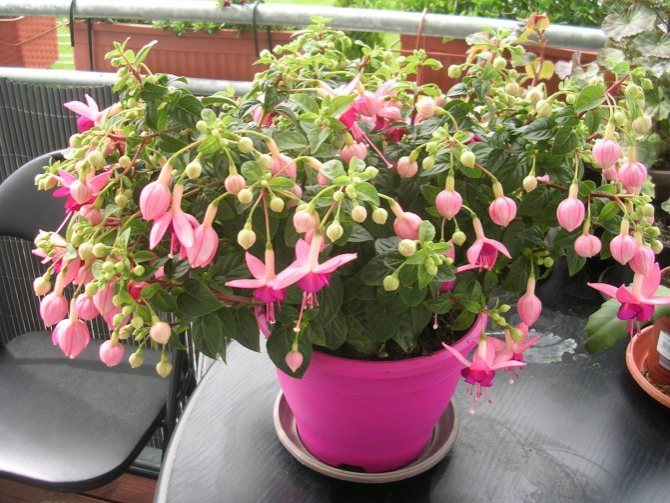

The plant will respond with gratitude for good care.
Sometimes fuchsia is planted in open soil outside. But if the air heats up to 30 ° C, then the plant will instantly shed its leaves and begin to hurt, dry.
A ceramic or porcelain pot will help keep the roots from overheating. The plastic container for flowers heats up, the ceramic keeps it cool.
Important! In the summer heat, the fuchsia root system will be perfectly preserved in a spacious ceramic pot. It stays cool in the heat and protects the plant roots from overheating.

